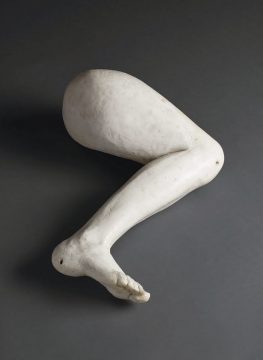Emily LaBarge at Artforum:
 Biography drags after Szapocznikow like a phantom limb, threatening to eclipse a practice as rooted in materiality and experiment as it is in the individual life experience of a body and mind. Born to a Jewish family in Kalisz, Poland, in 1926, she survived two ghettos and three concentration camps, as well as tuberculosis, before dying of breast cancer at age forty-six. Her work has frequently suffered from being interpreted too literally, theorized as representations of trauma or of psychic wounds. But every encounter I’ve had demands the opposite: The abstracted figuration Szapocznikow pursued in this later work, which hovers between the real body and its imagined or felt states, demands nuanced reading. We have the body truncated, unheroic, beguiling, as in her colored polyester resin lamps, mouths, and breasts lit from within—glowing sentinels pink, flesh colored, black, crimson. The body that grows where it shouldn’t, whose parts we cannot integrate, appears unnatural but unsettlingly erotic, tactile, as in two works titled Tumeur (Tumor), both made around 1970, consisting of lumpy mounds of resin and gauze, with ruby-red lips straining to the surface from within.
Biography drags after Szapocznikow like a phantom limb, threatening to eclipse a practice as rooted in materiality and experiment as it is in the individual life experience of a body and mind. Born to a Jewish family in Kalisz, Poland, in 1926, she survived two ghettos and three concentration camps, as well as tuberculosis, before dying of breast cancer at age forty-six. Her work has frequently suffered from being interpreted too literally, theorized as representations of trauma or of psychic wounds. But every encounter I’ve had demands the opposite: The abstracted figuration Szapocznikow pursued in this later work, which hovers between the real body and its imagined or felt states, demands nuanced reading. We have the body truncated, unheroic, beguiling, as in her colored polyester resin lamps, mouths, and breasts lit from within—glowing sentinels pink, flesh colored, black, crimson. The body that grows where it shouldn’t, whose parts we cannot integrate, appears unnatural but unsettlingly erotic, tactile, as in two works titled Tumeur (Tumor), both made around 1970, consisting of lumpy mounds of resin and gauze, with ruby-red lips straining to the surface from within.
more here.
